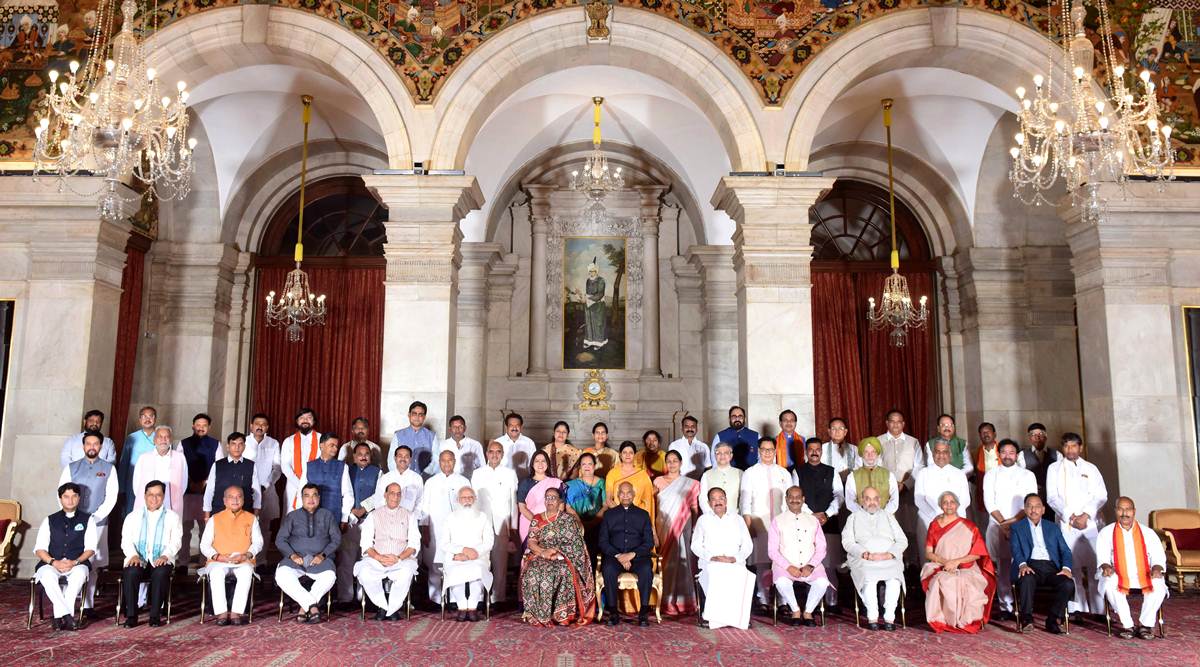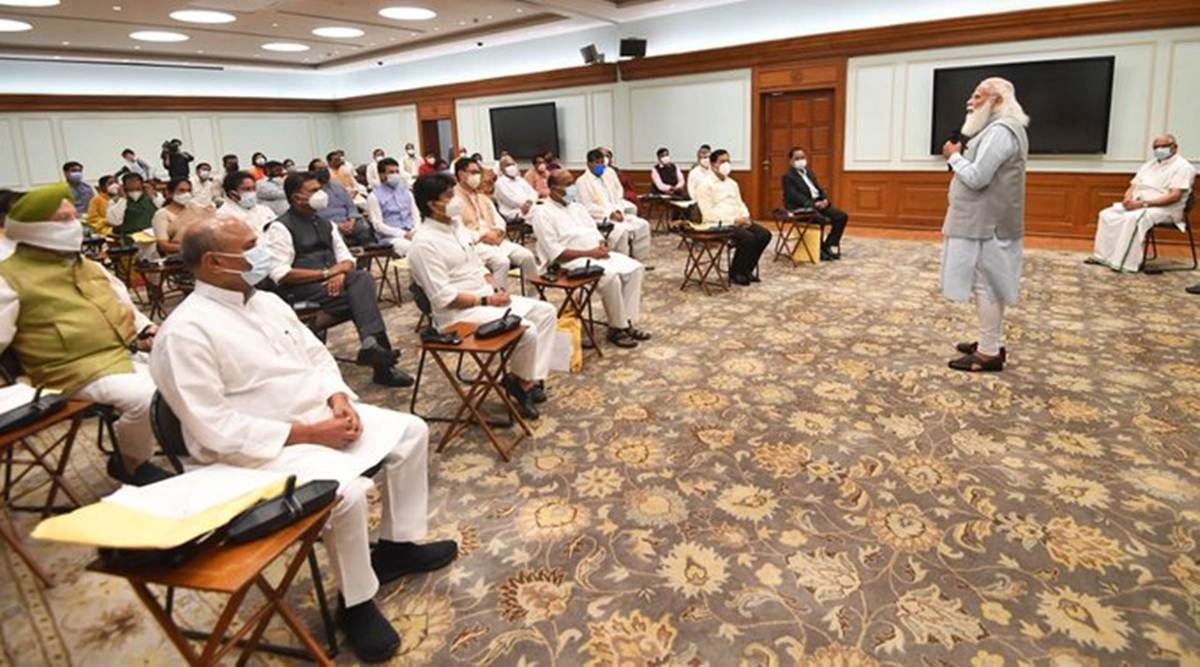 Prime Minister Narendra Modi and his new Council of Ministers with President Ram Nath Kovind and others at Rashtrapati Bhavan in New Delhi on Wednesday. (Photo credit: Rashtrapati Bhavan)
Prime Minister Narendra Modi and his new Council of Ministers with President Ram Nath Kovind and others at Rashtrapati Bhavan in New Delhi on Wednesday. (Photo credit: Rashtrapati Bhavan) HIS Government’s image hit by a crisis of capacity and credibility during the second Covid wave, Prime Minister Narendra Modi Wednesday signalled a reset effecting the most sweeping change in his Council of Ministers since he took charge for the first time in 2014.
As many as 36 new faces were inducted and 12 sitting ministers were shown the door taking the tally in the Council of Ministers to 78 (including the PM), just a notch short of the statutory limit of 81.
The changes mark, arguably, the largest-scale purge in recent times with the Prime Minister divesting six of 23 sitting Cabinet ministers — over one fourth — and one Minister of State (Independent Charge) of their ministerial responsibilities.
Social Justice Minister Thaawarchand Gehlot can draw solace from the fact that he was sent to Raj Bhavan in Karnataka. Health Minister Harsh Vardhan’s exit has a ready and convenient cover: the Government’s thinly veiled acknowledgment of mismanaging the Covid crisis and an attempt to course-correct through a fresh set of hands.
But many in the ruling establishment are searching for reasons behind the exit of others: DV Sadananda Gowda, Ravi Shankar Prasad, Ramesh Pokhariyal Nishank, and Prakash Javadekar (all Cabinet Ministers) and Santosh Gangwar (MoS Independent Charge).
 Narendra Modi handpicked new and young leaders to nurture and energise the sectors ravaged by the pandemic — from health and education to labour, civil aviation, IT and petroleum.
Narendra Modi handpicked new and young leaders to nurture and energise the sectors ravaged by the pandemic — from health and education to labour, civil aviation, IT and petroleum.
More so, given the fact that all these ministers consistently – and faithfully — read the government’s brief whether it was on neem-coated urea (Gowda); hobbling Chinese electronics and software app firms and taking Twitter to task for its alleged political bias (Prasad); National Education Policy (Nishank); environmental clearances (Javadekar) or labour codes (Gangwar).
Incidentally, five of the seven senior exits happened from social sector ministries – Health, Education, Social Justice, Labour, and Environment – while leaving most of the core economic ministries unchanged. This despite the fact that the economy has sputtered even before the pandemic and now faces a string of challenges – from growth to inflation.
Five more Ministers of State exited paving the way for new faces from their respective states: Babul Supriyo, Debasree Chaudhari (both from West Bengal); Sanjay Dhotre (Maharashtra); Ratan Lal Katariya (Haryana); and Pratap Chandra Sarangi (Odisha).
These exits come after the Prime Minister’s free-wheeling discussions with the ministers in small groups after the second Covid wave abated. Sources said the Ministers got no indication of their imminent exit as the final call was taken after calculations of governance and political imperatives made by the government and the party leadership.
The Council of Ministers which had depleted from 57 — when the new government took over in May 2019 — to 53 after resignation and exit of allies will now be a massive 77-member strong.
The exit of six Cabinet ministers was compensated by induction of 15, which included seven sitting ministers elevated to Cabinet rank.
The eight new members brought directly to the Cabinet are two former Chief Ministers Narayan Rane and Sarbananda Sonowal, along with leaders of allies – RCP Singh and Pasupati Paras — while Bhupender Yadav and Virendra Kumar bring their role as heads of parliamentary committees to the table. Former UPA minister Jyotiraditya Scindia was also elevated to Cabinet ostensibly for his role in bringing theBJP to power in Madhya Pradesh in March last year.
This radical rejig, the first in the second term, is also being seen as an attempt to signal a break from the “political noise” of the previous two years. There is also a sense in the government that ideological projects had a governance cost and set off social and political anxieties.
These include the nationwide anti-CAA protests, the farmers’ protests, the worst communal riots in Delhi since the 1984 anti-Sikh riots, the prolonged internet ban in Jammu and Kashmir, the widespread migrant distress in the pandemic’s first wave and the devastating loss of lives in the second.
Beyond the immediate task of resetting governance at the Central level, the fresh inductions factor in electoral and political goals for balance three years of the government’s tenure. So the expansion brought in new faces with an eye on their electoral utility for regions and communities they represent.
To this effect, the expansion seeks to strike a balance between social and sub-regional representation in large states key to the BJP’s electoral fortunes: UP, Maharashtra, West Bengal, Karnataka and Gujarat, that account for over 200 Lok Sabha seats.
By including representatives from the JD(U) and rebel LJP faction, the BJP also hopes to deepen its alliances in Bihar given how the party has lost two of its oldest allies – Shiv Sena and Akali Dal – in last two years.
So while UP got seven new ministers (three Dalits and three OBCs and one Brahmin), four new ministers have been inducted from Maharashtra, Karnataka and West Bengal, and three new ministers from Gujarat along with two elevations to Cabinet rank (Parshottam Rupala and Mansukh Bhai Mandaviya).
At a broader level, there are 11 women, about 27 OBC Ministers in the council while 12 belong to SC and eight are from Tribal communities. and 11 women. The Council also spans a wide geography, from North-east to the south.
- The Indian Express website has been rated GREEN for its credibility and trustworthiness by Newsguard, a global service that rates news sources for their journalistic standards.

